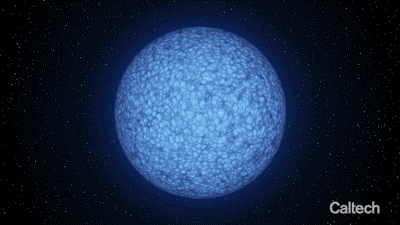White dwarfs are the exposed burned-out cores of dead stars that have gone through the red giant phase but are not heavy enough to go supernova. This is the destiny of our Sun. Astronomers have now announced a totally weird white dwarf, which sports two different faces. One side is covered in hydrogen, and the other one is covered in helium.
The objected is nicknamed Janus, after the two-faced Roman god of transition. It was discovered by the Zwicky Transient Facility (ZTF) and followed up by several telescopes; they revealed that Janus rotates on its axis every 15 minutes, changing its brightness rapidly. Observations looking at the chemical composition of this dead star revealed the two very different sides.
“The surface of the white dwarf completely changes from one side to the other,” lead author Dr Ilaria Caiazzo, from Caltech, said in a statement. “When I show the observations to people, they are blown away.”

An artist’s impression of what the white dwarf might look like as it rotates.
Image credit: K. Miller, Caltech/IPAC
The white dwarf has a temperature of 35,000 degrees Celsius (63,000 degrees Fahrenheit) and it is baffling scientists. It is not at all clear how a white dwarf might end up with two different sides. There are several theories that the team has proposed and are looking to test further. One of them is that Janus has been seen undergoing changes, making the name even more fitting.
“Not all, but some white dwarfs transition from being hydrogen- to helium-dominated on their surface,” Caiazzo explained. “We might have possibly caught one such white dwarf in the act.”
This might explain what they are seeing, but it is still not clear how the distinct faces come to be. Multiple explanations rely on the powerful magnetic field that can be produced in white dwarfs.
“Magnetic fields around cosmic bodies tend to be asymmetric, or stronger on one side,” Caiazzo explained. “Magnetic fields can prevent the mixing of materials. So, if the magnetic field is stronger on one side, then that side would have less mixing and thus more hydrogen.”
This is one possibility. But the magnetic field can also play a part in more or less constraining the plasma around white dwarfs, creating different pressures and densities in their atmospheres.
“The magnetic fields may lead to lower gas pressures in the atmosphere, and this may allow a hydrogen ‘ocean’ to form where the magnetic fields are strongest,” added co-author James Fuller, professor of theoretical astrophysics at Caltech. “We don’t know which of these theories are correct, but we can’t think of any other way to explain the asymmetric sides without magnetic fields.”
Janus is so far unique, but the team hopes that it won’t remain so for long. They hope to use ZTF to find more objects like Janus and understand the mechanism that led to its peculiar surface composition.
The study is published in Nature.
Source Link: First-Ever Two-Faced White Dwarf Is A Bizarre And Unique Object